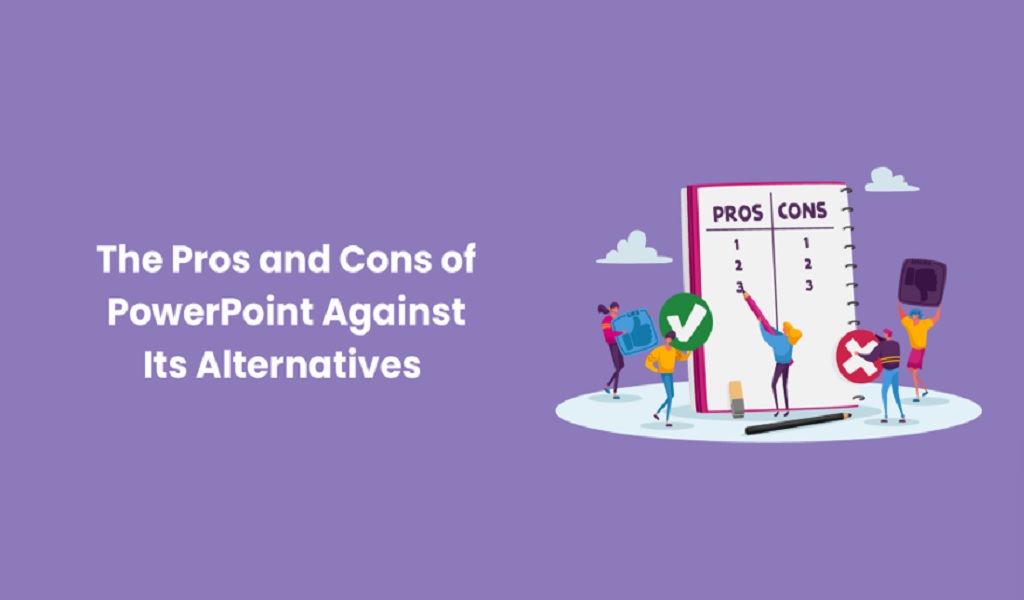Successful communication is essential to every endeavour. Both people and organisations rely significantly on presentation software to perfect this art. Making engaging presentations has long been associated with PowerPoint because it holds a dominant position when it comes to presentation. Microsoft Office Training can help you get better at making presentations. However, there are several other PowerPoint Alternatives that you can opt for. We will examine the benefits and drawbacks of PowerPoint as well as its substitutes in this blog.
Table of Content
- PowerPoint Alternatives
- Pros of PowerPoint Alternatives
- Cons of PowerPoint Alternatives
- Conclusion
PowerPoint Alternatives
These options each have features and capabilities that appeal to a wide range of presentation requirements. Let’s have a look at some of the best PowerPoint alternatives:
Prezi
Presenters may build visually captivating presentations with Prezi’s renowned non-linear, zoomable canvas. It provides a novel viewpoint on narrative and works especially well when explaining difficult ideas.
Google Slides
Google Slides is a cloud-based application that excels at collaborative work in real-time. Multiple users may collaborate on a presentation simultaneously, making it perfect for remote teams and instructors.
Canva
Canva’s usefulness extends beyond presentations; its user-friendly design tools let you easily create aesthetically appealing slides. For individuals who value presenting aesthetics above all else, this is their go-to platform.
Keynote
Keynote by Apple is a powerhouse for Mac users. It integrates well with other Apple devices and has amazing animation and design capabilities.
Zoho Show
A component of the Zoho Office Suite, Zoho Show is well-known for its cloud-based accessibility and collaboration tools. It’s a formidable alternative for companies seeking an all-inclusive workspace.
Pros of PowerPoint Alternatives
PowerPoint alternatives have carved out significant benefits over regular PowerPoint in the realm of presentations. Let’s look at the benefits of utilising these alternatives:
Unique Presentation Styles
Canva and Prezi are two alternatives that provide creative and eye-catching information presentation techniques. Your presentations may stand out and draw your audience’s attention with their dynamic animations and non-linear patterns.
Real-time Collaboration
When it comes to collaborative work, Google Slides excels. Multiple users may simultaneously modify and comment on a presentation, making it ideal for team projects, webinars, and workshops. Real-time cooperation increases efficiency and innovation.
Cost-Effective Options
Comparing several PowerPoint substitutes with Microsoft Office, you might find cheaper or free membership options. Budget-conscious startups, small enterprises, and educational institutions may find this cost-effectiveness especially alluring.
Enhanced Compatibility
Some solutions store presentations in formats more compatible with different devices and systems, lowering the likelihood of formatting problems when sharing files. This enhanced compatibility might help to speed communication with customers and coworkers.
Offline Access
Although cloud-based systems are widely used, offline access options such as Keynote and Zoho Show guarantee that you can present even without an internet connection.
Cons of PowerPoint Alternatives
While PowerPoint alternatives have significant benefits, they are not without restrictions. Let us look at some of the disadvantages of choosing these alternatives:
Learning Curve
Making the switch from PowerPoint to an alternative might be labour-intensive. It could be necessary for users to acquaint themselves with novel interfaces, functionalities, and presentation formats. People and groups may encounter a barrier to this learning curve used to the ease of use of PowerPoint.
Offline Access Challenges
Offline access is provided by various alternatives. However, it is not necessarily as frictionless as PowerPoint’s original desktop program. This may be difficult if you depend on presentations in regions with little or no internet access.
Compatibility Concerns
While alternatives work hard to be compatible, there’s no assurance that your favourite format will work with everything. This might become a problem when sharing presentations with partners or customers using different software.
Limited Advanced Features
Some PowerPoint alternatives may lack the advanced features and functionalities of PowerPoint. If your presentations require intricate animations, macros, or specific plugins, you may find these options limited in alternatives.
File Export and Conversion Issues
You can run into formatting issues while exporting presentations to other formats or converting them to PowerPoint. During the conversion process, this may result in losing functionalities or design features.
Conclusion:
Finally, the key to making the appropriate decision is to understand your goals, analyse your audience, and assess the requirements of your staff. Consider the features, financial constraints, and compatibility aspects that are most important to you.

















